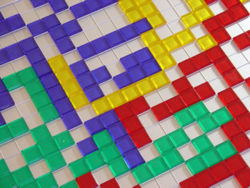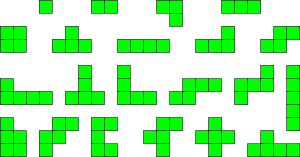Blokus
2007 Schools Wikipedia Selection. Related subjects: Games
| Blokus | |
|---|---|
 |
|
| Players | 2–4 |
| Age range | 5 + |
| Setup time | < 1 minute |
| Playing time | 20 - 30 minutes |
| Random chance | None |
| Skills required | Strategic thought |
| BoardGameGeek entry | |
Blokus is an abstract strategy board game for two to four players, invented by Bernard Tavitian and published in 2000 by the Sekkoia company. It has won several awards, including the Mensa select award and the 2004 Teacher's Choice Award. Tavitian, an engineer and artist was inspired to create the game while trying to find an appropriate frame for a painting of an orchestra made up of geometric figures.
The correct pronunciation of the name Blokus has been the subject of some debate. The game's inventor is French, and implies that a French pronunciation may differ, but he referred the question to game's US distributor, who responded: "We pronounce it with a "soft o" as in "block." But many customers seem to pronounce it with a "long o" as in "Blow-kus.".
Gameplay
The goal is to get rid of all of the 21 pieces you initially start off with. The pieces are all of the free polyominoes using one to five squares (rotations and reflections don't count). On each player's turn, they can put one of their remaining pieces on the 20 square by 20 square board. Each piece must connect to another piece of the same colour by at least one touching corner, but no two pieces of the same colour can share an edge (so they cannot tessellate into each other).
The novice typically tries to seal off an area for themselves to reduce the area the opponents can access. But since pieces only are connected via their corners, another player can easily pass through. It is therefore difficult to cut off other people from accessing 'your' area. Instead, the successful tactic is to try to expand into as many areas on the board as possible. In other words, game strategy is dominated by offence rather than defence. Blocking is possible to an extent by cutting off an opponents access to the corners of their pieces using yours in strategic ways.
The smaller tiles are very useful during the later stages of the game: the smaller a piece is, the better it is at occupying the holes in the tiles of other colours, and thus opening up new areas of the board for expansion. It often happens that no player can finish off all their tiles. The score is calculated by deducting a point for each square left on a player's remaining pieces (leaving you with a negative score). Should you ever manage to play all your pieces, you get a bonus score of +15. Achieving this, and having played your single-square piece last gets you another five points for a final score of +20.cumulatively.
In a four player game, each player takes a different colour, and play rotates around in a clockwise direction. With two players, each player takes two colours, starting in opposite corners. This allows further strategy, as a player can sacrifice one of their colours in order to strengthen the position of their other colour in order to try and play all the pieces of that colour and win the bonus score.
In the three-player game, the players take turns playing for the fourth colour (blue). Because the players must play out of corners of the board, one player will always be playing out of the corner opposite to blue. It is widely believed that this is an advantage. The reason for this is that blue is generally used as a tool to block the other player’s moves. For most of the early game, the player opposite blue is too far away to be successfully blocked, but can still use the colour itself to block others. Various methods have been suggested to solve this problem, but it is recommended that players come to an agreement among themselves that best suits their preferences.
Variant rules and boards
As Blokus is a very simple abstract game, it lends itself to fans developing variant rules of play. Since there are only two rules to begin with, it is easy to add rules without breaking or unbalancing the game. Here are a few such variants:
Draft Blokus
This variant solves the problem of a three-player game by allowing all players to play pieces from all different colors. The strategy in Draft Blokus is quite a bit subtler than in standard blokus, and the draft that takes place before the game is almost a game unto itself.
The players take turns drafting the pieces that they will play with. Each color is drafted separately until each color has been drafted. The players alternate taking first pick of each colour. Once every piece has been drafted, play proceeds as normal.
Notes: each player has a mix of pieces of different colors, but the rules for placement are the same. Sometimes a situation will arise in which a player skips a turn for lack of a move, but then is able to play again later due to subsequent moves made by other players. Though this does not contradict the rules of Blokus, it would be impossible in a standard game of blokus.
Reverse Blokus
This variant is an unusual alternative, and is like playing a game of standard blokus as poorly as you can. This variant works well in games of two, three, or four players, though the three-player game suffers from the same imbalance as in standard blokus.
Once no players can make any more moves, the player with the fewest tile segments on the board wins.
Variant Two Player
In this alternate way to play with two players, the board is divided down the middle, and both players play only on a single half of the board, each playing with only a single colour. Otherwise, the game is played identically.
Obstacle Blokus
The game is played with one, two, or three players. Each player chooses one colour, and the remaining colors become the obstacle colors. The players first take turns placing the obstacle colors. Once the obstacle colors have been exhausted, the players choose starting corners (these are not chosen at the beginning of the game) and play proceeds as normal.
Cooperative Blokus
Four players work together with the goal of having all players place all their pieces on the board by the end of the game.
Team Blokus
A four player game, where they make teams consisting of two players. The members of a team play cooperatively with one another with the goal of having all their pieces places on the board by the end of the game. Game play proceeds as normal.
Pirate Blokus
Played as normal Blokus, except that the 1 piece (gold coin, or eye patch) must be played first. Originally suggested by amaretto and phillylama, 2 of the World's best players from the online Blokus.com game site. Players are encouraged to talk like pirates.
Expansions and spinoffs
Blokus Duo/Travel Blokus
Blokus Duo uses a smaller (14×14) board, two of which are marked as the starting squares, and supports only two players. Each player chooses one colour (purple, orange), and the order of play is determined by any mutually agreeable method. The first piece played by any player must cover the starting squares.
This game tends to be faster and more aggressive, since the players start in the middle of the board, as opposed to its edges.
Blokus Trigon
Blokus Trigon uses pieces made up of triangles rather than squares, and is played on a hexagonal board. The game can be played with three players without giving one player an undue advantage.
Blokus Giant
Blokus Giant is essentially like regular Blokus, except bigger (with the game board being about 2' square).

